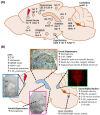A Decade of Progress in Deep Brain Stimulation of the Subcallosal Cingulate for the Treatment of Depression
- PMID: 33053848
- PMCID: PMC7601903
- DOI: 10.3390/jcm9103260
A Decade of Progress in Deep Brain Stimulation of the Subcallosal Cingulate for the Treatment of Depression
Abstract
Major depression contributes significantly to the global disability burden. Since the first clinical study of deep brain stimulation (DBS), over 406 patients with depression have now undergone this neuromodulation therapy, and 30 animal studies have investigated the efficacy of subgenual cingulate DBS for depression. In this review, we aim to provide a comprehensive overview of the progress of DBS of the subcallosal cingulate in humans and the medial prefrontal cortex, its rodent homolog. For preclinical animal studies, we discuss the various antidepressant-like behaviors induced by medial prefrontal cortex DBS and examine the possible mechanisms including neuroplasticity-dependent/independent cellular and molecular changes. Interestingly, the response rate of subcallosal cingulate Deep brain stimulation marks a milestone in the treatment of depression. DBS among patients with treatment-resistant depression was estimated to be approximately 54% across clinical studies. Although some studies showed its stimulation efficacy was limited, it still holds great promise as a therapy for patients with treatment-resistant depression. Overall, further research is still needed, including more credible clinical research, preclinical mechanistic studies, precise selection of patients, and customized electrical stimulation paradigms.
Keywords: deep brain stimulation; major depressive disorder; medial prefrontal cortex; subcallosal cingulate; treatment-resistant depression.
Conflict of interest statement
The authors declare no conflict of interest.
Figures

References
-
- Collaborators GBD 2017 Disease and Injury Incidence and Prevalence. Global, regional, and national incidence, prevalence, and years lived with disability for 354 diseases and injuries for 195 countries and territories, 1990–2017: A systematic analysis for the Global Burden of Disease Study 2017. Lancet. 2018;392:1789–1858. - PMC - PubMed
-
- Ferrari A.J., Charlson F.J., Norman R.E., Patten S.B., Freedman G., Murray C.J., Vos T., Whiteford H.A. Burden of depressive disorders by country, sex, age, and year: Findings from the global burden of disease study 2010. PloS Med. 2013;10:e1001547. doi: 10.1371/journal.pmed.1001547. - DOI - PMC - PubMed
-
- American Psychiatric Association . Diagnostic and Statistical Manual of Mental Disorders. 5th ed. American Psychiatric Association Publishing; Washington, DC, USA: 2013.
-
- Kendler K.S., Walters E.E., Neale M.C., Kessler R.C., Heath A.C., Eaves L.J. The Structure of the Genetic and Environmental Risk Factors for Six Major Psychiatric Disorders in Women: Phobia, Generalized Anxiety Disorder, Panic Disorder, Bulimia, Major Depression, and Alcoholism. Arch. Gen. Psychiatry. 1995;52:374–383. doi: 10.1001/archpsyc.1995.03950170048007. - DOI - PubMed
Publication types
Grants and funding
LinkOut - more resources
Full Text Sources

